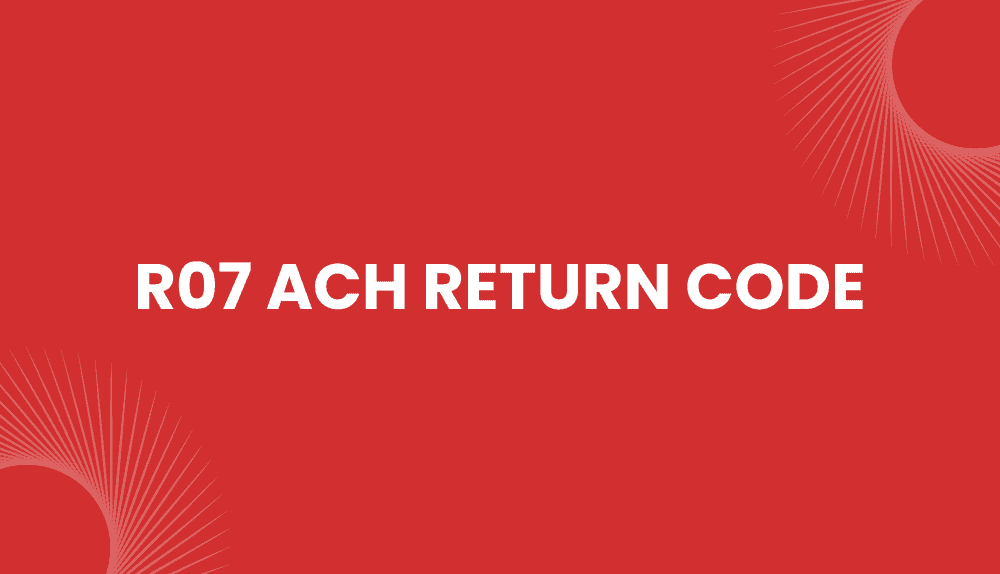In the intricate realm of electronic payments, where every transaction is a symphony of interconnected financial instruments, a single note out of tune can cause ripples that echo far and wide. In this captivating symposium of finance, one of the most intriguing and consequential phenomena is the enigmatic “R07 ACH Return Code: Authorization Revoked by Customer.”
Like a sudden shift in a musical composition, this seemingly innocuous code carries the power to alter the course of digital transactions, revealing tales of contested authorizations, customer dynamics, and the delicate dance between businesses and their clients. As we delve into the depths of this captivating world, we shall uncover the mysteries behind the elusive R07 ACH Return Code, where the melody of financial trust intertwines with the discord of revoked permissions.
What Does ACH R07 Return Code Mean?

The ACH R07 return code, often referred to as “Authorization Revoked by Customer,” is a significant indicator within the Automated Clearing House (ACH) network that denotes a reversal of a transaction due to the withdrawal of customer authorization. When this code is applied to an ACH transaction, it signifies that the customer or account holder has withdrawn their consent for the specific transaction to take place. This withdrawal of authorization may occur for various reasons, ranging from a change in the terms of the agreement to a dispute over the validity of the transaction.
The R07 return code plays a crucial role in safeguarding the rights and interests of consumers, ensuring that they retain control over their finances and the transactions initiated from their accounts. Financial institutions rely on this code to reverse payments, protecting customers from unauthorized or erroneous debits. In essence, it acts as a protective shield against potential abuse of ACH transactions.
For businesses and organizations, encountering the R07 return code can be a moment of introspection, urging them to reassess their communication with customers and the clarity of their authorization processes. It underscores the importance of obtaining clear and informed consent from customers before initiating any ACH transaction to avoid potential disputes and minimize the risk of encountering this return code.
Overall, the ACH R07 return code represents a pivotal aspect of the ACH network, preserving the delicate balance between businesses and consumers and serving as a reminder of the significance of transparent and mutual agreements in the financial landscape. Understanding its implications is crucial for all stakeholders to ensure a harmonious and efficient ACH transaction environment.
Reasons ACH R07 Return Code Can Occur

The ACH R07 return code, also known as “Authorization Revoked by Customer,” is an essential mechanism in the Automated Clearing House (ACH) network that indicates the withdrawal of customer consent for a specific transaction. This return code plays a vital role in safeguarding consumers’ rights and interests while highlighting the importance of transparent and mutual agreements between businesses and customers. Let’s delve into the various reasons why the ACH R07 return code can occur.
Inadequate Authorization
One common reason for encountering the ACH R07 return code is insufficient or unclear authorization. When businesses fail to obtain proper consent from customers before initiating ACH transactions, it opens the door to potential disputes. Customers may later dispute the transaction, claiming that they did not authorize the debit or that the authorization provided was not explicit enough. This lack of clear consent triggers the R07 return code, leading to the reversal of the transaction.
Revocation of Authorization
As the name suggests, the ACH R07 return code is specifically designed to handle cases where customers revoke their authorization for a specific transaction. Customers may choose to revoke their consent for various reasons, such as changing service providers, disagreeing with the terms of the transaction, or simply deciding they no longer wish to engage in a particular financial activity. In such instances, financial institutions are obligated to honor the customers’ wishes and reverse the transaction, utilizing the R07 return code as a mechanism for doing so.
Disputed Transactions
ACH R07 return codes can also arise due to disputes between customers and businesses. If a customer contests the validity of a transaction and claims that it was unauthorized or improperly executed, the financial institution will initiate the R07 return code process to reverse the payment and address the dispute. Resolving these disputes often involves investigation and collaboration between the involved parties to determine the legitimacy of the claim and decide on a fair resolution.
Changes in Agreements
Sometimes, businesses may modify the terms of an existing agreement with a customer without obtaining explicit consent for the updated terms. In such cases, if the modified terms lead to an ACH transaction, the customer may revoke their authorization upon discovering the changes. As a result, the ACH R07 return code may be applied to reverse the transaction and address the discrepancy in consent.
Technical Errors
In certain instances, ACH transactions can encounter technical errors during processing. These errors can lead to incorrect or unauthorized debits from customer accounts. If customers report such discrepancies, financial institutions may utilize the ACH R07 return code to rectify the situation, reversing the erroneous transaction and restoring the affected funds to the customer’s account.
The ACH R07 return code serves as a critical safeguard within the ACH network, ensuring that customers retain control over their financial transactions and protecting them from unauthorized or erroneous debits. Businesses must prioritize obtaining clear and explicit authorization from customers to avoid encountering the R07 return code due to inadequate consent. By understanding the reasons behind the occurrence of the ACH R07 return code, stakeholders can work towards fostering a more transparent and trustworthy financial landscape for all parties involved.
Steps to Fix R07 ACH Return Code

Fixing the ACH R07 return code requires careful attention to detail and prompt action to address the underlying issue causing the authorization revocation. Financial institutions and businesses must work together to resolve the problem and ensure that future ACH transactions proceed smoothly. Here are the steps to fix the ACH R07 return code:
Identify the Transaction in Question
The first step is to identify the specific ACH transaction that triggered the R07 return code. This involves reviewing transaction records and identifying the customer account involved, the transaction amount, and the date of the failed transaction.
Contact the Customer
Once the transaction is identified, the next crucial step is to contact the customer or account holder to understand the reason for the authorization revocation. Reach out to the customer through appropriate communication channels, such as email or phone, to seek clarification and address any concerns they may have regarding the transaction.
Investigate the Issue
Upon speaking with the customer, conduct a thorough investigation into the cause of the revoked authorization. Determine whether the issue arose from an error on the part of the business or a misunderstanding with the customer. This investigation may involve reviewing customer communications, authorization forms, and any changes made to the transaction agreement.
Resolve the Issue with the Customer
Depending on the nature of the problem, work towards resolving the issue in a manner that satisfies the customer’s concerns. If the authorization was revoked due to a misunderstanding or technical error, provide the necessary clarifications and rectify the situation. If the customer had genuine reasons to revoke the authorization, discuss alternative solutions or propose an amended agreement if appropriate.
Update Authorization Records
Following the resolution of the issue with the customer, update the authorization records accordingly. Ensure that any changes in the customer’s consent are accurately reflected in the business’s records to prevent future occurrences of the ACH R07 return code for the same transaction.
Reattempt the Transaction
If the customer agrees to proceed with the ACH transaction after resolving the issues, reattempt the transaction. However, ensure that the revised authorization is in place and that the customer is fully aware of the transaction details.
Preventive Measures
To prevent future instances of the ACH R07 return code, businesses should implement preventive measures. This includes improving communication with customers, obtaining explicit and clear authorization for all transactions, and maintaining accurate records of customer consent.
By following these steps and prioritizing open communication with customers, businesses and financial institutions can effectively resolve ACH R07 return code issues and build stronger relationships with their customers in the process.
How Can Businesses Deal with ACH R07 Return Code
Dealing with the ACH R07 return code requires a proactive and customer-centric approach from businesses. It is essential to address the underlying issues promptly, maintain transparent communication with customers, and implement preventive measures to minimize the occurrence of the return code in the future. Here are some effective strategies that businesses can adopt to handle the ACH R07 return code:
Prompt Communication
As soon as a business becomes aware of the ACH R07 return code, it should initiate immediate communication with the affected customer. Promptly reach out to the customer through phone, email, or other communication channels to understand the reason for the authorization revocation. Being responsive and addressing the issue swiftly can help prevent the situation from escalating and maintain a positive customer relationship.
Investigate the Root Cause
Thoroughly investigate the cause of the revoked authorization. Review the customer’s account, transaction records, and authorization documents to determine the reason behind the dispute. By understanding the root cause, businesses can take appropriate corrective actions to prevent similar issues in the future.
Customer Support and Issue Resolution
Provide exceptional customer support during the investigation and resolution process. Show empathy and understanding towards the customer’s concerns. If the issue is due to a misunderstanding or technical error, resolve it promptly and offer a sincere apology if necessary. If the revocation is justified, explore alternative solutions to address the customer’s needs and maintain their satisfaction.
Update Authorization Records
After resolving the issue with the customer, update the authorization records accurately. Ensure that any changes to the customer’s consent or transaction details are properly recorded to avoid future occurrences of the ACH R07 return code for the same transaction.
Enhance Authorization Process
To prevent the ACH R07 return code from happening frequently, businesses should improve their authorization process. Obtain explicit and clear consent from customers before initiating ACH transactions. Make sure the authorization terms are easily understandable and that customers are fully aware of the details of the transactions they are authorizing.
Regular Review of Authorizations
Periodically review and update customer authorizations to ensure they are up-to-date and in compliance with the latest agreements. This review process can help identify potential issues in advance and provide an opportunity to address them proactively.
Communication with Financial Institutions
Maintain open lines of communication with the financial institution processing the ACH transactions. Collaborate with them to understand the reason behind the return code and work together to resolve any recurring issues.
By implementing these strategies, businesses can effectively handle the ACH R07 return code, maintain strong customer relationships, and reduce the likelihood of encountering authorization-related issues in the future. Prioritizing customer satisfaction and compliance will ultimately contribute to a smoother ACH transaction process and a positive reputation for the business.
Final Words
In conclusion, the ACH R07 return code, “Authorization Revoked by Customer,” serves as a critical mechanism in the world of electronic payments, safeguarding consumer rights and financial transactions. By understanding the reasons behind its occurrence and adopting proactive measures, businesses can effectively deal with this return code. Prompt communication with customers, thorough investigation of issues, and updating authorization records are vital steps in resolving the ACH R07 return code instances.
Moreover, enhancing the authorization process and maintaining transparent communication with financial institutions can significantly reduce the likelihood of encountering such issues in the future. By prioritizing customer satisfaction and compliance, businesses can foster trust, strengthen relationships, and ensure a smoother and more secure ACH transaction environment for all stakeholders involved.
Frequently Asked Questions (FAQs)
Why did I receive an ACH R07 return code for my transaction?
You may have received the ACH R07 return code because the customer whose account was debited revoked their authorization for the transaction. This could be due to various reasons, such as a change in terms, a dispute over the transaction’s validity, or a technical error.
How should I respond to an ACH R07 return code?
When you encounter an ACH R07 return code, promptly communicate with the affected customer to understand the reason for the revocation. Investigate the issue, and if it was due to a misunderstanding or error, resolve it promptly. Update authorization records and consider alternative solutions to address the customer’s concerns.
Can the ACH R07 return code be prevented?
Yes, businesses can take preventive measures to reduce the likelihood of encountering the ACH R07 return code. These measures include improving the authorization process, obtaining clear and explicit consent from customers, and maintaining accurate records of customer authorizations.
Is the ACH R07 return code reversible?
Yes, the ACH R07 return code is reversible. Once the underlying issue is resolved and the authorization records are updated, the transaction can be reattempted with the customer’s consent.
How can businesses improve their authorization process to avoid the ACH R07 return code?
To avoid the ACH R07 return code, businesses should ensure that they obtain explicit and clear consent from customers before initiating ACH transactions. They should also review and update customer authorizations regularly and maintain transparent communication with customers regarding transaction details.
Can the ACH R07 return code impact my business’s reputation?
Yes, frequent occurrences of the ACH R07 return code can negatively impact a business’s reputation. It highlights issues with the authorization process and may lead to customer dissatisfaction. Implementing preventive measures and promptly addressing the code’s occurrence can help mitigate any negative effects on your business’s reputation.

